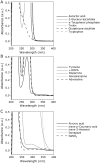Effects of additives on reaction of nucleosides with UV light in presence of uric acid and salicylic acid
- PMID: 36447488
- PMCID: PMC9701597
- DOI: 10.3164/jcbn.22-23
Effects of additives on reaction of nucleosides with UV light in presence of uric acid and salicylic acid
Abstract
Recently, we reported that uric acid and salicylic acid are photosensitizers of the reaction of nucleosides with UV light via radical formation and energy transfer, respectively. In the present study, effects of 45 biologically relevant compounds on nucleoside reactions photosensitized by uric acid and salicylic acid were examined. When a mixed solution of 2'-deoxycytidine, 2'-deoxyguanosine, thymidine, and 2'-deoxyadenosine with uric acid was irradiated with UV light of a wavelength longer than 300 nm, all the nucleosides decreased. The addition of antioxidants suppressed the consumption of nucleosides. When the UV reaction of nucleosides was conducted with salicylic acid, thymidine decreased almost exclusively. Several antioxidants such as ascorbates, thiols, catecholamines, trans-2-hexen-1-ol, penicillin G, and NaHSO3 enhanced the consumption of thymidine, although the other antioxidants suppressed it. The results suggest that antioxidants may be beneficial to protect against DNA damage by photosensitization via radical formation, but that several of them may be detrimental as they facilitate DNA damage by photo-sensitization via energy transfer.
Keywords: antioxidant; nucleoside; photosensitizer; salicylic acid; uric acid.
Copyright © 2022 JCBN.
Conflict of interest statement
No potential conflicts of interest were disclosed.
Figures



Similar articles
-
Uric Acid as a Photosensitizer in the Reaction of Deoxyribonucleosides with UV Light of Wavelength Longer than 300 nm: Identification of Products from 2'-Deoxycytidine.Chem Pharm Bull (Tokyo). 2021;69(11):1067-1074. doi: 10.1248/cpb.c21-00501. Chem Pharm Bull (Tokyo). 2021. PMID: 34719588
-
Reactions of 3',5'-di-O-acetyl-2'-deoxyguansoine and 3',5'-di-O-acetyl-2'-deoxyadenosine to UV light in the presence of uric acid.Genes Environ. 2022 Jan 21;44(1):4. doi: 10.1186/s41021-022-00234-5. Genes Environ. 2022. PMID: 35063039 Free PMC article.
-
α-Tocopherol phosphate as a photosensitizer in the reaction of nucleosides with UV light: formation of 5,6-dihydrothymidine.Genes Environ. 2022 Feb 15;44(1):6. doi: 10.1186/s41021-022-00237-2. Genes Environ. 2022. PMID: 35168665 Free PMC article.
-
Safety assessment of Salicylic Acid, Butyloctyl Salicylate, Calcium Salicylate, C12-15 Alkyl Salicylate, Capryloyl Salicylic Acid, Hexyldodecyl Salicylate, Isocetyl Salicylate, Isodecyl Salicylate, Magnesium Salicylate, MEA-Salicylate, Ethylhexyl Salicylate, Potassium Salicylate, Methyl Salicylate, Myristyl Salicylate, Sodium Salicylate, TEA-Salicylate, and Tridecyl Salicylate.Int J Toxicol. 2003;22 Suppl 3:1-108. Int J Toxicol. 2003. PMID: 14617432 Review.
-
Actions of ultraviolet light on cellular structures.EXS. 2006;(96):131-57. doi: 10.1007/3-7643-7378-4_6. EXS. 2006. PMID: 16383017 Review.
References
-
- IARC. IARC Monographs on the Evaluation of Carcinogenic Risks to Humans, Vol. 100D “Solar and ultraviolet radiation”. Lyon: IARC Press, 2012; 35–101. - PubMed
-
- Hicks MR, Kowałski J, Rodger A. LD spectroscopy of natural and synthetic biomaterials. Chem Soc Rev 2010; 39: 3380–3393. - PubMed
-
- Cadet J, Vigny P. The photochemistry of nucleic acids. In: Morrison H., ed. Bioorganic Photochemistry: Photochemistry and the Nucleic Acids. Vol. 1, Chap. 1. New York: Wiley, 1990; 1–272.
-
- von Sonntag C. Free-Radical-Induced DNA Damage and Its Repair: A Chemical Perspective. Berlin: Springer-Verlag, 2006.

